Budapest is one of the most photogenic cities in the world. With its grand architecture, stunning river views, and lush green parks, there are endless photo opportunities in every corner of the city. If you’re looking for some of the best spots, here’s our location guide for Budapest photography.
The jewel of the Danube is the Capital of Hungary. It houses around 3.3 Million people on two sides of the same river, splitting it into Buda and Pest. The settlement of this great city started before the 9th century. Since then, it has been the home of many influences. These range from conflicting cultural and architectural occupations.
The Széchenyi Thermal Baths are one of 80 thermal baths you can find in Budapest. This is one of the most photographed bathhouses due to its size. Its architectural style and its popularity make for great shots.
It is the largest medicinal bath in Europe. The water comes from two thermal springs, and the temperature runs between 74 °C and 77 °C.
As a Budapest location, it’s an ample space to capture. Most photographers stick to the outside pools, which are better to visit in the summer. You will find atmospherical scenes due to the rising steam in the strong sun.
One of the best images you can capture is the Hungarian men playing chess while bathing. It is iconic and will create great travel photography.

I know, I know. Széchenyi was a significant Hungarian politician, political theorist, and writer.
As Budapest locations go, this is one of the most famous. It crosses the Danube in front of the Four Seasons Gresham Palace and links Clark Adam Tér to Széchenyi Tér. It is one of the best places to cross when visiting the Buda Castle on foot.
Built in 1949, the bridge holds a high stature in Europe. It is to Budapest what the Brooklyn Bridge is for New York. AIt is one of the best Budapest photography locations. Here you get a cast-iron structure with four lion statues on each corner.
Destroyed during World War II, it was rebuilt like every other bridge in the Captial. Now it stands taller than ever and appears on Syfy channel’s 12 Monkeys and a few other movies and music videos.

If you are looking for panoramic views of the capital city, you will not find them on the Pest side. This is unless you visit a rooftop bar. On the Buda side, you can keep your feet firmly on the ground. This is while standing in one of the best photography spots in Budapest.
This hill stands 235 m (771 ft) tall, and its size means it sits in two different districts. The name comes from Saint Gerard, the first Bishop of Csanád, thrown off the hill. On one side of the hill is a statue commemorating his life.
At the bottom of this hill, you will find Gellért Baths, another beautiful thermal spa inside Hotel Gellért. On the top of the hill, you will find the Citadella. On top of this fortress, the Liberty Statue – a 14-meter tall bronze woman holding a palm leaf.
Not only is this a great place to capture the sunset, but it offers an almost 360 panoramic view of the entire city. This is where you need to come to for the Budapest skyline and wide cityscape shots.
It’s even better to come after the sun drops to capture Budapest at night.
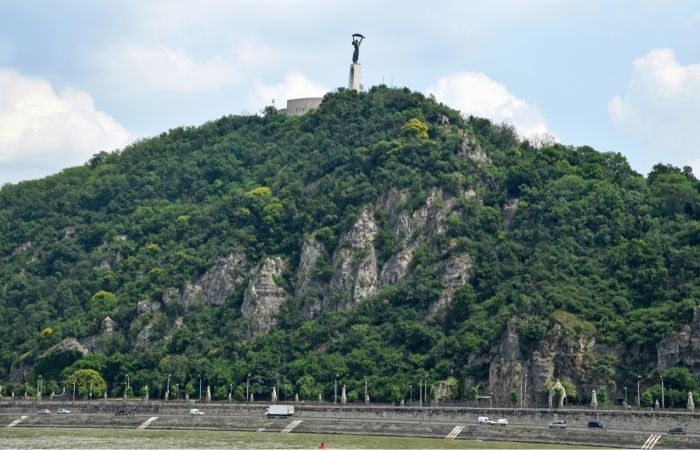
The Danube is the heart of the city of Budapest. This river cuts the capital city into its respective halves, Buda and Pest. This is the place to go to get great images of both sides.
From the Buda side, you will find one of the best places to capture the Hungarian Parliament. Behind it, the retreating skyline. Along the Buda promenade, you get to see the Várkert Bazaar. This is a recently renovated neo-Renaissance arcade of boutiques.
You will also get to see the Turkish-style bathhouse Rudas Baths up close. Capturing both promenades makes this one of the best photography locations in Budapest.
The Pest side offers excellent views of Gellért Hill and the Citadella. Not to mention Buda Castle with the number 2 tram in the foreground. The universities located on the riverside also offer beautiful architecture.
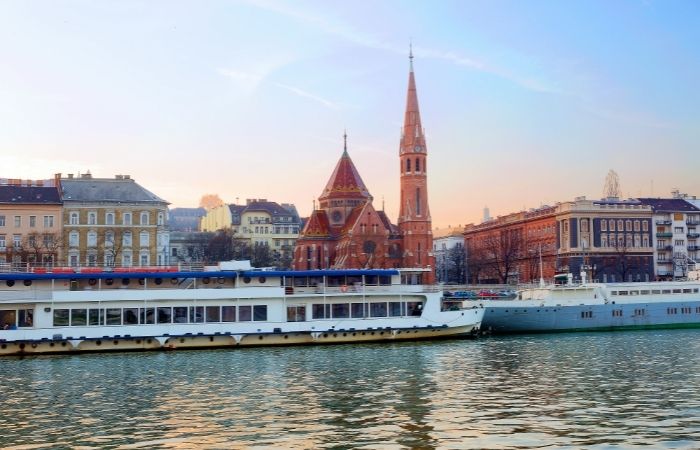
Heroes Square (Hősök tere) is a famous photography spot in Budapest. It is located at the end of Andrássy út and the city park’s start (Városliget).
This boulevard had its name changed three times in one decade. Andrássy út became Sztálin út (“Stalin Street”) during the Soviet occupation in 1950. It changed to Magyar Ifjúság útja (Avenue of Hungarian Youth) During the 1956 uprising.
In 1957, the governing government reviewed the name and changed it to Népköztársaság út (People’s Republic Street). The former name of Andrássy returned in 1990. The fall of the Iron Curtain signaled the end of the communist era.
The square sits between two colossal art museums, the Museum of Fine Arts and the Műcsarnok.
You will find many opportunities to capture this major square. It is a meeting place and famous for bringing people together. They are political events, music concerts, rallies, and the site for one of the world’s largest human peace symbol.
Without all the human interaction, this area houses many statues and monuments. Firstly, the center of the square is the Millenium Monument. This is a blend of three parts: the column, the Archangel top-piece, and the Seven original chieftains at the bottom.
Semi-circling the back of the square are two colonnades. These statue complexes represent Labour, Wealth, War, Knowledge, Glory, and Peace.
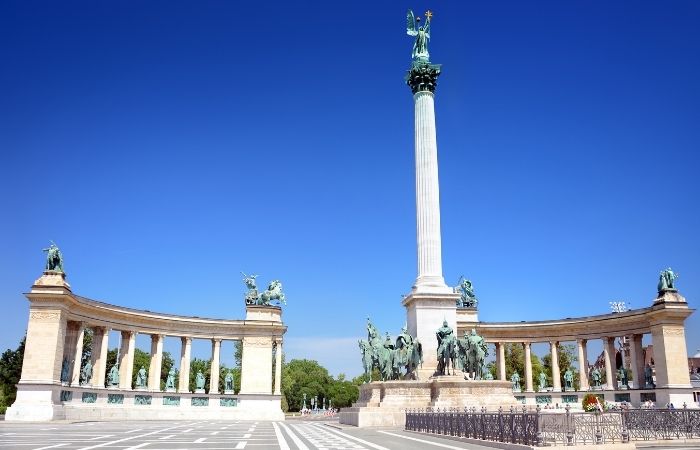
Another of the top photography spots in Budapest is St. Stephen’s Basilica. The surrounding square is also photogenic. Here, you can capture the Church head-on. Or scale the 364 stairs for a 360° panoramic view of Budapest from its dome.
Named after the first King of Hungary who reigned from 975–1038 AD. In fact, the King’s right hand is on show in the shrine inside.
The Basilica follows the Neo-classical style of architecture. It is only the third-largest church in Hungary, albeit the most important.
There are many angles and perspectives to capture this delight. Due to its design and art housed inside, it serves as one of Budapest’s best indoor photography locations. It also provides excellent images of Budapest at night.
The square in front of the Basilica is a great meeting point and should be your first port of call. Here, you will find a photogenic obelisk with an accompanying fountain.
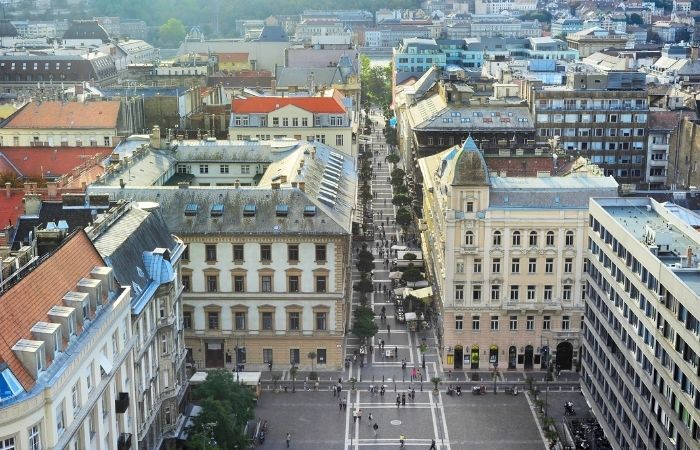
Gellért Hill is a great photography spot to capture, but it is even better to use it as a vantage point. It is 235 m (771 ft) high and feels like it after walking up all those stairs.
It overlooks the Danube and most of the bridges found in the Capital. You will see the Basilica, the Parliament, the Budapest eye, including the Budapest skyline.
The Citadella on top of the hill provides a few statues that you can use to place into the foreground of your images.
From here, you get an almost panoramic 360° viewpoint, and great all year round. You will see ice flows during the colder seasons coming down the river. Fog also restricts the view after the bridge hits the Pest side.

The Church (Mátyás-templom) and the Bastion (Halászbástya) are next to each other. You will find them in the Buda Castle district on the Buda side.
This Roman Catholic church was built in the Romanesque style. But, after over 1000 years, not of it remains. What you will see is a Neo-gothic style that was restored in the late 19th century.
The Fisherman’s Bastion is a fortress wall pointing towards the Danube below—built in the neo-Gothic and neo-Romanesque style between 1895 and 1902.
Here, you will find seven towers. Each one represents one of the seven Magyar tribes that first settled here. There is also a bronze statue of Stephen I of Hungary riding a horse, surrounded by stone carvings representing episodes from his life.
There are crevices, arches, and one fantastic viewpoint from the lookout terrace.
Personally, this is one of the best photography spots in Budapest for me. I could spend hours capturing the church’s exterior and every element of the Bastion. For you, you will catch some of the best travel photography possible.
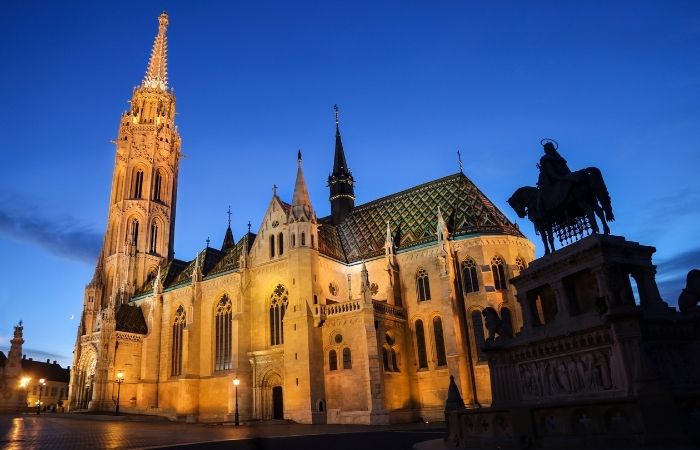
The Buda castle offers many photographic opportunities. They will help your travel photography and show Budapest off in a great light. This palace complex was first completed in the mid-13th century. Most of what you will see came from before 1770.
Named the Royal Palace or Royal Castle, it contains the Hungarian National Gallery and the Budapest History Museum. It has a great viewpoint of Clark Adam tér, Chain Bridge, and the Funicular.
There is a statue of a legendary Turul bird, a sacred bird of the Magyars. It spreads its wings above Budapest, giving you a great foreground with shots of the city in the background.
From here, there are many great ways to capture Budapest. At nighttime, you can capture many great scenes. The Chain Bridge and the Parliament in one portrait-orientated shot, for example. This is where a telephoto lens would come in very handy.
When there are fireworks in the city, this is a great place to shoot from. If you are into long exposures or timelapse photography, this is one of Budapest’s top spots.
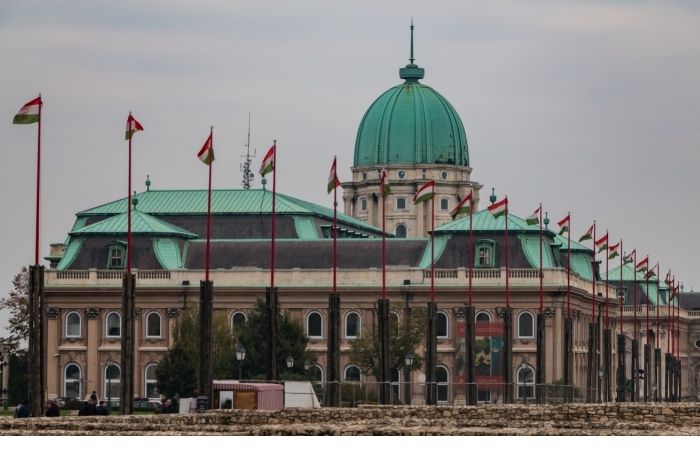
The Hungarian Parliament Building (Országház) is, for me, one of the best photography spots in Budapest. It is one of the most beautiful buildings I have seen in my travels, and it’s one of the most important.
Not only is the exterior easy to capture. But it is also one of the best indoor photography locations in Budapest. It is the largest building in Hungary. And the third biggest parliament building in the world.
The neo-gothic revival style of the building is somewhat common in Budapest. You’ll find the same architectural trend in other buildings: the Fishermans’ Bastion, Mattias’ Church, the Paris Court, and the Ministry of Finance.
You will notice that the building is symmetrical, inside as it is on the outside. This is handy, as one side is for all political communication, while the other is for tours.
Inside there are ten courtyards, 27 gates, 29 staircases, and 691 rooms. Each is as photogenic as the last. 242 sculptures adorn the walls, displaying kings, rulers, leaders, and military figures.
The frescoes, stained glass windows, and ornaments, such as gold cigar holders, make this a great place to photograph.
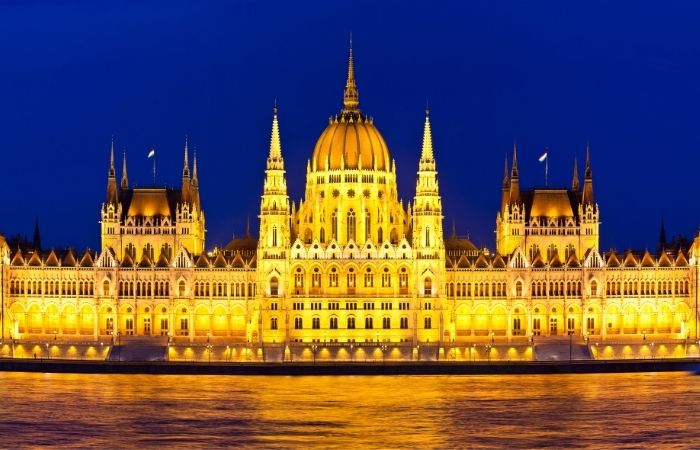
Budapest serves as a central hub in Eastern Europe. The country borders seven others, making it an excellent place for excursions. Two hours in any direction, and you will find a different language, culture, and currency. This also means some of the continent’s best photography spots are in Budapest.
Apart from the rich history, you will find an interesting language and fascinating culture. There are many visual delights that Budapest also offers, making it perfect for photographers. Not to mention those turning points that put this city on the map. All in all, Budapest is one of the most beautiful cities in the world, and one that is too often overlooked.
Create fun minimalist shots of Budapest on your phone with our Urban Smartphone Minimalism course!